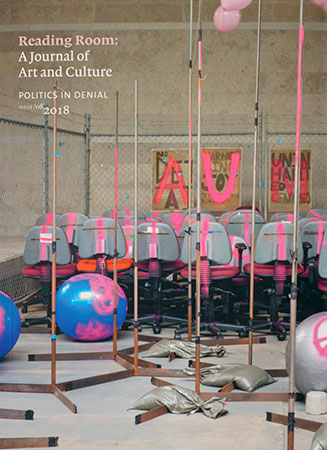John Hurrell – 8 January, 2019
David Hall's richly varied and amazingly thorough keynote essay, ‘Admit Nothing, Mapping Denial', elaborates on the intricacies of political denial, effortlessly pulling together the history of governmental fiscal policies, Te Ao Māori, continental philosophy, methodologies of lying, and some visual art. It's dense but not convoluted, having a keenly apparent direction—while always rewarding careful rereading.
Reading Room: A Journal of Art and Culture
Issue #8: Politics in Denial
Edited by Christina Barton, Natasha Conland, Wystan Curnow
Contributors: Natasha Conland, Fiona Connor, Wystan Curnow, Betty Davis, Sarah Farrar, Simon Gennard, David Hall, Alfredo Jaar, Robert Leonard, Anna-Marie White, Victoria Wynne-Jones
Auckland Art Gallery Toi o Tamaki, 2018
With a particularly focussed line-up in this, the eighth—an especially tightly organised—issue, ‘Politics in Denial’, is I think the most interesting Reading Room so far, presenting an abundance of important essays that look at McCahon, et al., Vivian Lynn, John McLaughlin, te Tiriti, Pinochet, Marti Friedlander, the Women’s Movement, George Hubbard, Terror Internationale and Tiqqun. Certainly it is the most prescient thematically, particularly for this week in early January 2019, when we are witnessing the beginning of the collapse of Trumpian / Republican denial in the face of Democrat resurgence and control.
David Hall‘s richly varied and amazingly thorough keynote essay, ‘Admit Nothing, Mapping Denial’, elaborates on the intricacies of political denial, effortlessly pulling together the history of governmental fiscal policies, Te Ao Māori, continental philosophy, methodologies of lying, and some visual art. It’s dense but not convoluted, full of surprises and having a keenly apparent direction—while always rewarding careful rereading.
As does Natasha Conland’s immensely interesting look at the complex strategies implemented by et al. and it’s multiple preceding and current identities—and the key significant exhibitions presented by that art entity who (with the others) attempted to erase the deliberately never mentioned here, ‘Merylyn Tweedie.’ In ‘The Politics of Erasure: The artists et al.’, Conland goes through the different influences on the thinking of et al.—obviously working with interviews–looking at writers like Burnham and Derrida, and teachers like Tom Taylor and Roger Horrocks. It is a valuable, comprehensive article packed with detail.
Wystan Curnow‘s contribution, ‘Salvation Army Aesthetics: The Politics of Colin McCahon’s “Early Religious Paintings,”’ on the community of Christians, pacifists, socialists and communists that Anne and Colin McCahon were part of in the thirties and forties, vividly describes that highly politicised milieu (particularly during the period of the Second World War), and the attendant religious strains that affected Colin’s painting, such as those of New Testament narratives set in Nelson.
In 1940 McCahon wrote in a letter to his friend Toss Woollaston that he hoped people looking at his landscape images would end up “being happier for it and believing in God and then the brotherhood of men and the futility of war and the impossibility of people owning and having more right to a piece of land and air than anyone else.” Such views would have been anathema to most New Zealanders at the time, and Curnow emphasises this, something that Thomas Crow has pointed out (Curnow notices)—unlike earlier McCahon commentators like Gordon Brown.
The article (part of a coming book) discusses how many of McCahon’s friends were taken aback by his raw ‘primitivist’ style (it was calculatedly crude) and eclecticism of his 1948 exhibition at the Wellington Public Library, and by its political content. Disheartened, he did not return to Biblical subject-matter for at least a decade. Curnow’s essay, packed with art historical research and written in his intimate, chatty convivial style, is good at answering a lot of commonly asked questions about this generally mysterious artist, especially at this time in his career, just after the War.
Alfredo Jaar‘s disturbing selection of newspaper images from Chile in 1973, shows various leftwing intellectuals and Allende supporters being rounded up by Pinochet’s soldiers, and awaiting execution. The enlargements of their faces reveal their terror, while an added transcript of a telephone conversation between Nixon and Kissinger shows Kissinger (who is on his way to a football game) saying that the military coup is “Nothing of Very Great Consequence.”
Fiona Connor‘s project, a group of photographs taken by a Los Angeles newspaper of John McLaughlin paintings leaning outside in his garden in natural light, deny the ideology of the white cube and allure of modernist interior gallery architecture.
Anna-Marie White and Robert Leonard’s contribution, ‘George Hubbard: The Hand that Rocked the Cradle’, examines the pioneering art historical contributions of George Hubbard, Aotearoa’s first Māori curator, particularly his battles with Auckland City Art Gallery in 1996 over the Korurangi exhibition, and the catalogue essay he wrote for it. Like Curnow’s essay, this contribution will be a revelation to many readers.
In ‘Nothing Ever Happens’, Simon Gennard’s informative article discusses the radical theory collective Tiqqun, and their influence on the Bernadette Corporation video, Get Rid of Yourself (2003) a work which had an impact on Terror Internationale, the Auckland group of young Elam graduates thirteen years later.
The history of the Women’s Movement is also a significant component of this publication. Victoria Wynne-Jones writes on the documentation of the United Women’s Convention (held in Waikato University in 1879) by Marti Friedlander (she was invited by Marilyn Waring), Betty Davis discusses the Women’s Art Archive Interview Project, and Sarah Farrar elaborates on the controversial work by the late Vivian Lynn, Gates of the Goddess: A Southern Crossing Attended by the Goddess (1986).
As I’ve said, this issue of Reading Room is particularly interesting; very pertinent and clearly valuable with all the topics it covers. You can get it from the AAG bookshop.
John Hurrell

 Two Rooms presents a program of residencies and projects
Two Rooms presents a program of residencies and projects Advertising in this column
Advertising in this column



This Discussion has 0 comments.
Comment
Participate
Register to Participate.
Sign in
Sign in to an existing account.